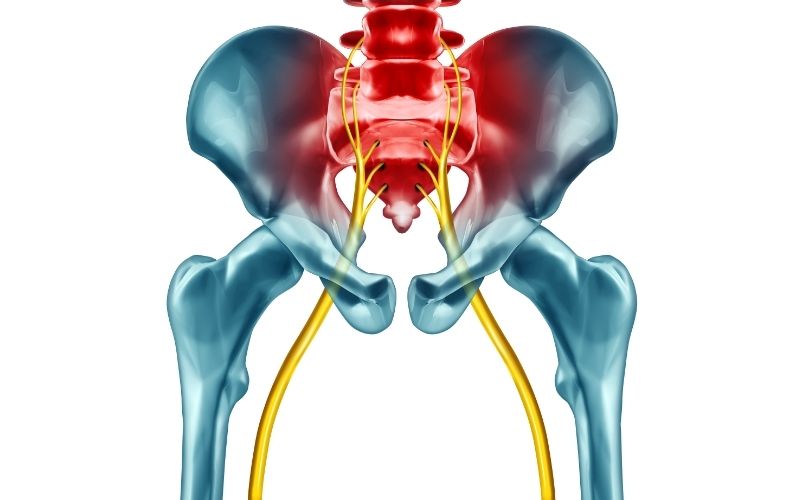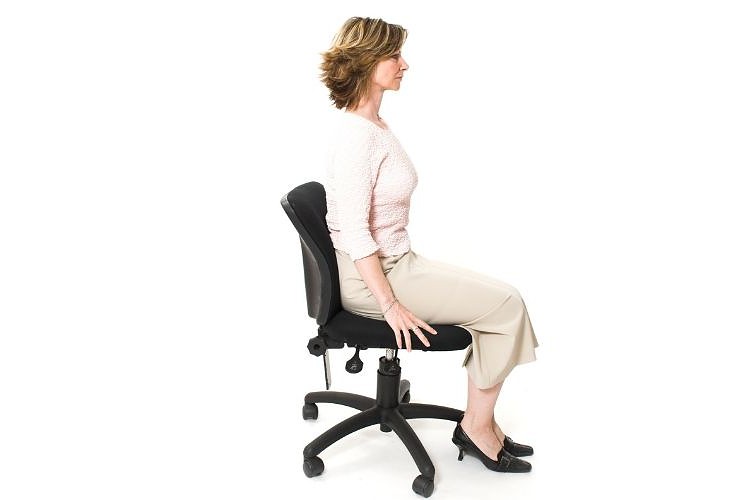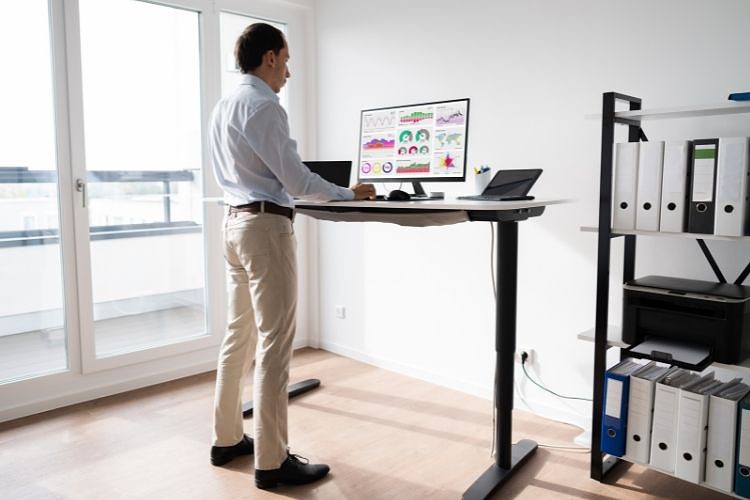The way we sit or stand can dictate how we feel physically and mentally. This is especially true for individuals dealing with sciatica.
Sharp pains coursing through your hips and spine are uncomfortable on the best of days. And it feels exponentially worse when you have things you need to get done for people who aren’t going to understand or sympathize with how crippling sciatica is.
Using a standing desk may help soothe or prevent sciatica-related pain. It doesn’t replace going to the doctor, but it is a medication-free way to get through the day comfortably.
Here’s everything you need to know about standing desks and how they might be able to help with sciatica.
Table of Contents
What is Sciatica?
To understand how and why a standing desk can be helpful, it’s important to break down what sciatica is and how it affects how you sit.

The sciatic nerve is a long, thick nerve that starts in the hip/pelvis area and runs down the length of both legs. The nerve is made up of five roots which all meet around the sit bone area, so any pain to the nerve will directly impact the hips and lower back.
While damage to the sciatic nerve can result in sciatica, it is also commonly used as a general term for pain that stems in the lower back and runs down the legs. Although often, pain will only occur in one leg.
Pain from sciatica can range from mild to serious. Generally, it will mend itself in a few days. In more grave cases, surgery is required to fix the nerve damage.

People usually describe sciatic pain as ‘shooting’, ‘stabbing’ or ‘burning’. It can be very unpleasant.
Sciatica makes sitting difficult, so you need to be mindful of your body’s alignment and posture. Because sitting can be challenging, some people prefer to stand when possible.
Is It Better to Stand or Sit With Sciatica?
There isn’t one straight answer to what position is best for sciatic. This is because the key to dealing with nerve damage is to not stay stagnant for long periods.

The biggest thing to look out for is moving from a seated position to a standing position. This can cause more pain and damage than actually standing or sitting.
If you have to choose between standing or sitting, you should opt for standing.
Move slowly and listen to your body. The sciatica nerve is thick and meets at the hips, so you want to be careful not to twist your lower body or move it too quickly.
Sitting puts a lot of pressure on your sciatic nerve. You’re resting your body weight on your lower back and hips, which presses down on the nerve.
Bending your legs may not always cause problems if you’re dealing with sciatica, but it may be painful to some individuals. Standing is a great way to take pressure off the nerve and straighten your legs.
Does Standing Make Sciatica Better or Worse?

Standing keeps your body active. You have to be in tune with your spine, knees, and hips in order to stand. Whereas with sitting, you can let your body go limp if you aren’t mindful of your posture the entire time.
The key to getting through a bout of sciatica is moving mindfully, so you want to avoid that.
You can help your sciatica by standing, provided that you stand in an ergonomically supported position.
You should also be mindful of how long you’ve been standing. Setting a timer for 30 to 60 minutes is a great way to keep track.
However, standing can also make sciatica worse. If you find yourself leaning to one side or putting too much pressure on one leg or side of your hips, you should readjust yourself.
How Should I Stand with Sciatica?
If you’re at work, having a standing desk makes standing a lot easier. You can still be productive and remain focused without compromising your health.
However, not all standing was created equally.

When you’re dealing with sciatica, you should have a small box to make standing more manageable.
Stand with your feet planted hip-length apart, this roots you to the ground and keeps you balanced.
Do not put one foot in front of the other! That might really hurt, and it isn’t a sustainable pose.
Place one foot on top of the small box. This will relieve your hip and leg from any painful pressure.
The box should be the size of a shoebox, but more firm and durable. Something made out of wood would be ideal. Just make sure it’s light enough to move around easily.
Once you’re in the position, set a timer or keep an eye on the time. You’ll want to switch which leg is elevated every 10 minutes or so.

You can alternate this for as many times as you feel comfortable before gently lowering your desk and sitting back in your ergonomic office chair. Remember, the key is to not stay in a position for too long. Movement is your medicine in this situation.
The entire time you’re standing, your back should be straight and your head and shoulders should be lifted. Standing tall (and proud) will prevent you from slouching, which could aggravate your sciatic nerve.
How Should I Sit with Sciatica?
Now that you know how to stand with sciatic, let’s break down how to sit with sciatica.

The key to sitting correctly with sciatica is keeping your limbs straight and aligned. The last thing you want to do is try to cross your legs.
Sitting crossed legged can prevent blood flow and put an even amount of pressure on your hips even when you feel fantastic–so it especially needs to be avoided when struggling with sciatica.
Crossing your legs can also cause inflammation, which can be painful.
Your feet should be grounded the entire time you’re sitting. You do not want to overstretch your legs because you’ll end up tugging at your sciatic nerve.
Keep your legs bent at a 90-degree angle. If you must lift a leg, make sure to only have one leg lifted at a time and to alternate them regularly.

Sitting in an office chair with wheels is ideal, since turning can hurt your spine or hips. If you have to turn around, use your legs to shuffle your chair around.
You could also stand up slowly and turn around to avoid twisting your body around.
This may take some time to become comfortable with, but it will help avoid any nasty shooting pains.
Finally, be sure to sit close enough to your desk. You want to avoid hunching over. If you have to extend your arms a lot to type on your computer, you’re too far away.
Proper Standing Desk Etiquette

Using a standing desk isn’t as simple as just standing however you want, especially if you’re dealing with sciatica!
The height of your standing desk is very important. It shouldn’t be much taller or shorter than the height of your elbows.
The best way to measure this is to extend your arms at a 90-degree angle like you’re typing.
Your computer screen should also be at a comfortable height. You do not want to need to move your neck up or down to look at it.

Like when sitting at a desk, you want to be close enough to where you don’t have to stretch your spine to reach your work.
At the same time, if you get too close, you may end up leaning on the desk, which may put your spine in a compromised position.
Most importantly, proper standing desk etiquette requires that you don’t use the standing desk in its standing position the entire day! Take breaks, sit down, and walk around. If you’re having trouble lowering your standing desk, you may need to reset it or replace the motor.
Conclusion
A standing desk could help sciatica symptoms if used properly. Doctors and other medical professionals have also recognized the benefits of using a standing desk.
If you’re prone to sciatica, talk to your general practitioner or physical therapist about how a standing desk might help you.
You may even be able to get part or all of the desk covered by your insurance!
Whether you’re sitting or standing, you need to always be mindful of your spine alignment and positioning of your hips and legs. Remember that the sciatic nerve runs through both legs and meets at the hips, so these areas are going to be very sensitive to pain.
Make sure to get an ergonomic office chair for the hours you aren’t standing. You need a chair with enough lumbar support to keep you sitting straight. Having wheels (that are in good condition) is also helpful.
If your sciatica persists, be sure to talk to a doctor.
Have you struggled with sciatica and found refuge in a standing desk? What is your go-to standing position when working at an elevated desk?
We’d love to know all about your experiences in the comments below!
Good luck!

My name is Vance, and I am the owner of To Ergonomics. Our mission is to improve your workflow by helping you create a supportive and welcoming environment. We hope that you’ll find what you’re looking for while you’re here.

